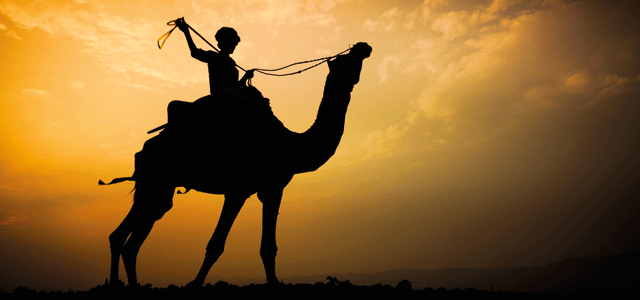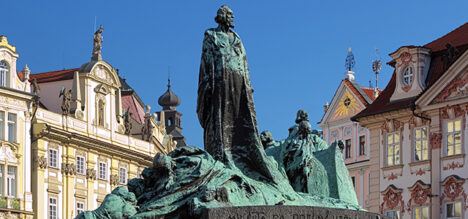Ur of the Chaldeans
July 31, 2012

David Down explores an ancient city that the Bible says was once home to Abraham, father of Israel.
Ur, an ancient city of the Sumerians, is situated in the south of today’s Iraq. It’s likely to be the world’s earliest documented civilisation, even ahead of Egypt, and considered to have been remarkably advanced. Its people were among the first to use cuneiform writing, and they developed a remarkable knowledge of mathematics and geometry.
It took a long time for the Sumerians to be identified, however. Even in early Bible history, there are only four references to Ur of the Chaldeans, and all of them refer to the same event: the patriarch Abraham’s departure from the place.
Tell Tales
In 1853, the British Museum approached the British Foreign Office requesting that the British representative in present-day Iraq be commissioned to search for treasures to grace British museums. The Foreign Office obligingly communicated the request to John George Taylor, the British vice-consul in Basra.
Taylor was not, of course, an archaeologist, nor had he any experience with excavations. However, as a willing servant of Her Majesty’s government, he no doubt welcomed a break from the office.
Rounding up a caravan of camels and donkeys laden with picks, hoes and supplies, he set out for Tell el-Muqayyar, which means “mound of pitch.” This ziggurat, or temple tower, was so named because its bricks were stuck together with bitumen or pitch. The ruins were obviously very historically important, but no-one until then knew their significance or purpose.
Arriving at the lonely desert site, approximately 150 kilometres northwest of Basra, Taylor made an inspection of the mighty ziggurat. Carefully tapping on the brick walls, he listened for any echo that would betray a hollow place within. There was none. The edifice was solid.
Undaunted, Taylor set his men to work on the top of the ruin. He was convinced that somewhere inside this temple there would be fabulous treasures that he could recover and proudly dispatch to London.
The Arab labourers obediently began their task, levering bricks from their place and hurling them to the ground below. The great temple tower that had withstood the ravages of thousands of years of heat, wind and driving sand began to yield to the onslaught of ignorant humankind.
But Taylor’s vision of graceful stone statues, golden gods and treasures was doomed to disappointment. Over two years of wearisome toil, he found numerous smaller items, such as rings, bowls, masks and vases, but nothing huge or spectacular. What he did find, he sent back to the British Museum.
In 1922, archaeologists began to realise that
Ur was a highly civilised city,
complete with a complex government
and busy trade and traffic.
The city’s infrastructure included
a drainage system, streets, two-storey houses
and a great temple tower.
Finding Ur
Some 60 years later, in 1918, the First World War was drawing to a close. The Turks had been driven out of the Euphrates Valley and the British army was in control.
One of the British officers in the area, Captain R Campbell Thompson, was attached to the army intelligence staff and was stationed near Tell el-Muqayyar. It so happened that before the war started, Thompson had been an assistant in the British Museum.
Thus, he took more than a casual interest in the towering ziggurat and the telltale mounds surrounding it. In fact, as opportunity provided, he did a little excavating of his own. Thompson was impressed with what he found and sent a recommendation back to the British Museum that it would be worth mounting a full-scale expedition to the site.
In response, the British Museum commissioned one Dr H R Hall to proceed to Tell el-Muqayyar and commence excavation. His experimental soundings revealed that they were looking at what could prove to be the world’s earliest civilisation. Lack of adequate funding, however, curtailed further digging.
In 1922, the University of Pennsylvania approached the British Museum with a proposal that a joint expedition be mounted and the British Museum accepted. Charles Leonard Woolley, later to be knighted for his outstanding work in the field, was placed in charge of the expedition. For the next 12 years, Woolley would patiently toil at the site, his wife also working with him much of the time.
It was from Woolley’s excavations that we learned the level of intelligence and sophistication of the people of Ur. They were highly intelligent and well educated. Their arts were well developed and they traded with countries far removed from them. For example, some semiprecious stones in their ornaments had come from the Nilgiri Hills in southern India!
The City Of Ur
The central feature of Ur was the giant ziggurat. This, and the surrounding temple complex, probably had its beginning in the city’s first dynasty. But it was enlarged and beautified by Ur-Nammu, a king of the third dynasty during which Ur reached the zenith of its power.
Houses during this and subsequent periods were of remarkably high quality. The rich possessed well constructed, two-storey homes that were built around an inner court.
A curious feature of all the houses in Ur was the drainage system. A shaft 10 or more metres deep was dug and a series of pottery rings inserted. This shaft then became a very effective soak pit for the family’s waste.
Education in Ur was of a remarkably high standard. Students learned grammar and mathematics in temple classes. There were lessons in verbs and nouns, multiplication and division, and geometry.
Neither the Bible nor archaeology tell us how Abram’s father, Terah, came to be in Ur, but the Bible does tell us that he was there and that he departed the city with his family. A large ziggurat dedicated to the moon god Nannar was in Ur. Perhaps Terah sensed that pagan worship was drawing his family away from the true God, or he may have received an instruction from God to leave. Whatever the reason, “Terah took his son Abram, his grandson Lot son of Haran, and his daughter-in-law, Sarai, the wife of his son Abram, and together they set out from Ur of the Chaldeans to go to Canaan. But when they came to Haran, they settled there” (Genesis 11:31).
Today, Haran is but a small village in southeast Turkey, but in early times, it was an important city on the trade route from the Persian Gulf to the Mediterranean.
To the Egyptians, the sun was the most evident manifestation of a deity; but to the people of Mesopotamia (where the Sumerians come from), the moon had a much stronger appeal.
According to Ya’acov Shkolnik in the Israeli magazine Eretz, “The sun always looked the same, while the moon changed form. Its magical power stemmed from its ability to regenerate itself.”
The months were measured by the moon. It changed shape and “more than any other celestial body, it was a living creature. It was born, grew, died and was reborn.”
Moving On From Ur
The Bible also does not tell us why Abram (who later became Abraham) did not immediately proceed to Canaan. Perhaps Terah was in poor health, for “he died in Haran” (verse 32). Abram did not tarry in Haran long after his father’s death, because God had other plans for him. Together with his retinue of servants and huge flocks of sheep and goats, Abram continued to follow the course of the Euphrates Valley into today’s Syria and then proceeded south-west and south to the land of Canaan.
Sometime after arriving in Canaan, a drought struck the land, causing severe famine. Thus, Abram and his family migrated temporarily to Egypt. When Abram arrived in Egypt, as a wealthy chieftain who came from a cultured society, he had dealings with the pharaoh, who appropriated his wife Sarai into his harem (Genesis 12:15).
Jewish historian Josephus claimed that Abram “communicated to [the Egyptians about] arithmetic, and delivered to them the science of astronomy; for before Abram came into Egypt, they were unacquainted with those parts of learning; for that science came from the Chaldeans into Egypt.”
Critics may dispute the reliability of this statement by Josephus, but it is significant that he should refer to such information when he would have had no way of knowing what we know today—that Ur was such an advanced seat of learning.
To the egyptians, the sun was the most evident manifestation of a deity; but to the people of mesopotamia (where the Sumerians come from), the moon had a much stronger appeal.
According to Ya’acov Shkolnik in the israeli magazine Eretz, “the sun always looked the same, while the moon changed form. It’s magical power stemmed from its ability to regenerate itself.”
The months were measured by the moon. it changed shape and “more than any other celestial body, it was a living creature. it was born, grew, died and was reborn.”
Adapted, with permission, from Unveiling the Kings of Israel (Green Forest, AR: Master Books, 2011).






